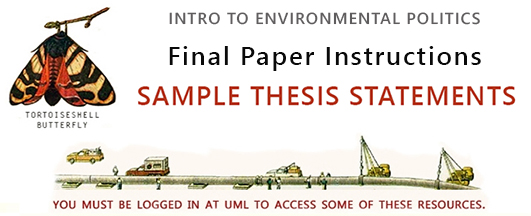

You must submit a polished first draft and a revised copy of a five-page paper (double-spaced, 11- or 12-point type, formatted in Microsoft Word, .doc or .docx extension). Please see the course calendar for deadlines. You may use any of the thesis statements below as is, rewrite any as you please, or compose a thesis statement on your own. Please note that the thesis statement is the only part of the paper that you may copy from an external source. If you copy any part of your final paper without attribution, you will receive an "F" for the paper, as well as an "F" in the course. Before you submit your first draft, you must consult the Term Paper Checklist to make sure that you have avoided common errors. If you received a "C" or below on your midterm, you must bring your first draft to the Writing Center to review it with a tutor before you send it in. If the quality of your draft suggests that you did not follow this instruction, your grade is likely to be lower than the one you received on your midterm.
Formula for Thesis Statements:
1. General Observation: "Scientists once believed..."
2. Qualification: "However, recent studies suggest..."
3. Statement of strategy: "By surveying some of these studies, this essay will show..."
Like Rachel Carson's Silent Spring, Henry David Thoreau's Walden is often cited as one of the founding texts of the environmental movement. But whereas Silent Spring galvanized public support for a new era of environmental regulation, the anti-political perspective of Walden has led Thoreau's environmentalist admirers to look for inspiration in his other writings, especially "Resistance to Civil Government" and "Slavery in Massachusetts." By explicating these two overtly political essays, this paper will explore Thoreau's relevance to environmental policy today.
Like Henry David Thoreau's Walden, Rachel Carson's Silent Spring is often cited as one of the founding texts of the environmental movement. In contrast to Thoreau's inspiring vision of nature, however, Carson provided a blueprint for practical environmental reform. By contrasting passages from Walden that focus on our duty to preserve the natural world with Silent Spring's call for government action, this paper will explore the differences and similarities between these two landmark contributions to environmental thought.
2012 and 2013, academics and activists looked back fifty years to the publication of Rachel Carson's Silent Spring (1962) and Betty Friedan's The Feminine Mystique (1963), books by two very different women that transformed American politics in similarly fundamental ways. Carson's work played a central role in sparking the environmental movement, while Friedan's ushered in a new chapter in the struggle for women's rights. Comparing the ferocious backlash that each of these landmark works ignited illustrates how far the women's movement has come since Friedan's time, as well as the progress that has yet to be made to realize the environmental ideals that Carson promoted.
One of the greatest challenges facing the American environmental movement is its need to overcome its origins in a time when the preservation of nature was overwhelmingly the province of white men with the means to travel to remote destinations. In "Marginal Voices in “Wild” America: Race, Ethnicity, Gender, and “Nature” in The National Parks," William E. O’Brien and Wairimu Ngaruiya Njambi address this challenge by examining the presentation of American environmental history in Ken Burns' documentary, The National Parks: America's Best Idea." By drawing from Burns' film and from examples provided by O'Brien and Njambi, this essay will explore the ways in which the outdated perspectives of privileged white men continue to shape environmental values in mainstream American culture.
In "Unequal Exposure to Ecological Hazards: Environmental Injustices in the Commonwealth of Massachusetts," Daniel R. Faber and Eric J. Krieg report that low-income communities in Massachusetts with high concentrations of non-white residents are much more likely to include sites that present environmental threats to human health. By providing a more detailed portrait of a few of the communities included in Faber and Kreig's study, this essay will explore the social and political factors involved in creating these environmental inequalities.
In response to charges that it has failed to respond meaningfully to the unequal exposure of low-income, non-white, and/or Native American communities to ecological hazards, the Environmental Protection Agency (EPA) has initiated efforts to integrate principles of environmental justice into its programs. However, environmental justice advocates have objected to the EPA's approach, pointing out that the agency's initiative is based on "environmental equity," which implies that it ought to "poison people equally," while the goal of the environmental justice movement is to "[s]top poisoning people, period." By examining ongoing debates about the EPA's environmental justice initiatives, this essay will assess whether the agency is likely to make significant progress.
During the 1970's, scientists confirmed that Earth's protective ozone layer was thinning over the Antarctic due to increasing concentrations of chlorofluorocarbons (CFCs) in the atmosphere. The global disaster that would have ensued if ozone depletion had continued was averted after CFCs were phased out under global agreements. What is striking about the implementation of this common-sense policy is how much harder it has been to enact similar measures to address climate change. By comparing the global response to ozone depletion to the relative inaction among American policy-makers in response to climate change, this essay will explore various reasons why the climate crisis has yet to inspire significant federal legislation.
One of the most challenging aspects of climate change is the need to understand and communicate its cascading effects to the general public. This challenge is especially apparent in the interplay between rising temperatures and the increasing acidification of ocean waters around the world. By summarizing the findings of the International Programme on the State of the Ocean (IPSO) for 2013, and integrating specific examples of threats to marine life from other studies, this paper will provide an overview of the ongoing interactions between ocean acidification and global warming.
Risk assessment is central to the development of sensible policy. Unfortunately, political and business groups opposed to taking action to address global warming have seized upon the uncertainties that are, by definition, integral to risk evaluation to argue that the consequences of climate change remain too unpredictable to warrant any shift in current policy, especially in regard to fossil fuels. By examining the case these groups have made against taking steps to address the threats posed by climate disruption, this essay will show that adopting their conception of risk would make it impossible to engage in any significant enterprise such as drilling for oil or selling petroleum products.
The Heartland Institute, a conservative think tank funded in part by oil, tobacco, and coal companies, has lately shifted from its usual practice of denying the existence of climate change to stressing the benefits of rising temperatures and high concentrations of carbon dioxide in the atmosphere. By drawing from a variety of sources to critique the studies that Heartland and others have used to support their celebration of carbon emissions, this paper will show that they proceed from the illusion that the steep growth in productivity caused by industrialization from 1900-2000 will continue to climb at the same rate for at least a hundred years.
In October 2016, the World Meteorological Society issued its annual report on the concentration of greenhouse gases in the atmosphere. According to the report, CO2 levels have apparently exceeded 400 parts per million (ppm), surpassing the 350ppm that climate scientists have defined as the ceiling we must stay below in order to avoid increasing climate disruption. The 400ppm threshold is symbolic, but it reinforces our urgent need to take action to curtail consumption of fossil fuels. Among the host of factors that militate against achieving this imperative, one of the most daunting is that even if we stopped using fossil fuels today, we will not drop below 400ppm for generations to come. After explaining why C02 levels will remain elevated for so long, this essay will explore how the timeline of global warming affects our ability to adopt sensible climate policies.
On November 4, 2016, the Paris Agreement (PA), a global initiative to combat climate change, entered into force after 110 of the 197 participating countries formally pledged to take steps to keep global temperatures in check. Although Donald Trump's election has dashed hopes that the U.S. would become a leader in implementing the PA, European and Asian signatories have already proposed ways to overcome the fossil-fuel revival that Trump has promised to pursue. By exploring a few of these proposals, this essay will evaluate how the PA might move forward in the absence of American leadership.
Uncertainty reigns when it comes to predicting the policies that Donald Trump might pursue as President of the United States. When it comes to climate change, however, Trump has been uncharacteristically consistent. His recent appointment of Myron Ebell, a well-known climate-change skeptic, to head the transition team for the Environmental Protection Agency (EPA) suggests that he will overturn existing climate initiatives and roll the U.S. back to full dependence on fossil fuels. By examining Ebell's career, as well as Trump's grand plans for the fossil fuel industry, this essay will provide some insight into the policy challenges we may face over the next four years.

